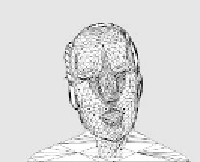Game Development Reference
In-Depth Information
Model-Based View Synthesis
In this section, experimental results of a model-based video coding scheme using
facial expression analysis are presented.
Figure 6 shows a head-and-shoulder video sequence recorded with a camera in
CIF resolution at 25 Hz. A generic head model is roughly adjusted in shape to the
person in the sequence and the first frame is projected onto the 3-D model. Non-
visible areas of the texture map are extrapolated. The model is encoded and
transmitted to the decoder and neither changed nor updated during the video
sequence. Only facial animation parameters and lighting changes are streamed
over the channel. In this experiment, 18 facial animation parameters are
estimated, quantified, encoded, and transmitted. The frames in the middle row of
Figure 6 are synthesized from the deformed 3-D model, which is illustrated in the
lower row of Figure 6 by means of a wireframe. The bit-rate needed to encode
these parameters is below 1 kbit/s at a quality of 34.6 dB PSNR. The PSNR
between synthesized and original frames is here measured only in the facial area
Figure 6: Upper row: Original video sequence; Middle row: Synthesized
sequence; Lower row: Hidden line representation.












Search WWH ::

Custom Search